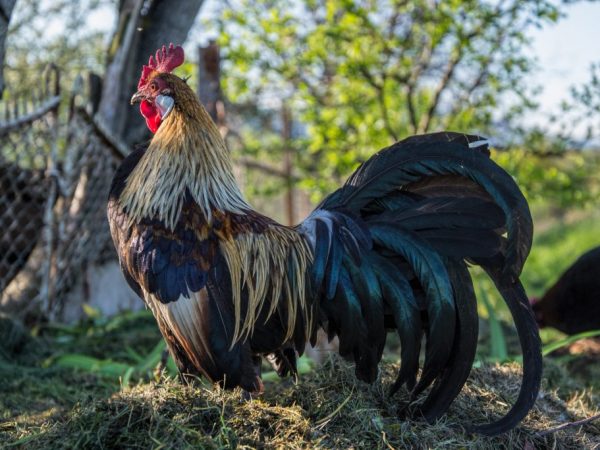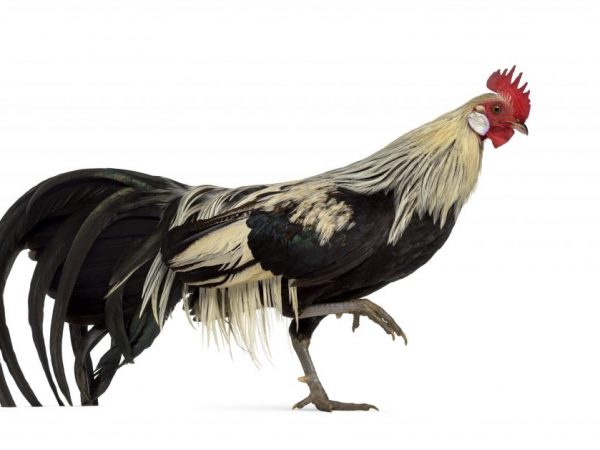Phoenix chickens
The decorative breed of Phoenix chickens arose as a result of crossing the sacred Japanese subspecies: yokohamo-tosa and onagadori with birds of other breeds. A distinctive feature is a long and beautiful tail, reaching more than 10 meters in some representatives.
- Brief information about the breed
- Full description
- The cost
- Appearance
- Character
- Incubation instinct
- Productivity
- Advantages and disadvantages
- Breeding features of this breed
- Incubation
- Chicks feeding
- Chick care
- Features of keeping adults
- What should be a chicken coop
- Food
- Place for walking
- Molt and break of egg production
- Possible diseases
- Owner reviews

Chickens of the Phoenix breed
In medieval Japan, there was a belief that long-tailed chickens were able to protect against misfortune and misfortune, so they could not be eaten and sold, but could be presented as a sign of respect. Yokohama and Onagador breeds were bred at temples and imperial palaces, and even taken out for a walk on special carts. Now there are two lines in the world - German (more common, with a tail length of up to 3 m) and Japanese (with a tail, on average, 7.5 m).
Brief information about the breed
- Productivity type: decorative.
- Rooster weight: medium-heavy (up to 2.5 kg).
- Chicken weight: medium (up to 2 kg).
- Ovipositor start: average (6-8 months).
- Egg production: medium (50-100 pieces).
- Features of the: long tail in cockerels requiring grooming; hens do not hatch eggs.
- Egg size: medium (50 g).
- Are they suitable for a beginner: Yes.
Full description
The long tail in roosters is the result of the loss of the gene responsible for annual shedding.
The birds are decorative and are intended more for exhibitions than for industrial breeding.
They do not ask for special care, with the exception of increased requirements for hygiene and equipping the chicken coop with perches.
The cost
The purchase price of representatives of the German line varies from 1200-2500 rubles. A hatching egg can be purchased for 200 rubles.
But it is extremely difficult to get Japanese birds, Phoenix chickens are still considered a shrine and their sale or murder is punishable by a serious fine.
Appearance
Phoenix males have a straight body, a wide and feathery back and a long tail, which grows 90 cm per year. The scallop is short and directed vertically, with white lobes on the earrings.
The beak is medium-sized, gray-blue or pale yellow.
Chickens are small, they have a short, erect comb with small earrings and a relatively elongated bushy tail. The color of the breed can be wild, white, orange, golden and silver-maned.
Character
The breed is characterized by increased intelligence and a calm temperament. Sometimes there are aggressive birds.
Cockerels love to pose, they are artistic and also caring towards chickens. Birds prefer to peck at snow and take long walks in winter.
Incubation instinct
Phoenix females have practically lost their incubation instinct, so eggs are placed in an incubator or placed in chickens of other breeds.
In rare cases, females still hatch eggs, but this happens if the hen was raised by a hen of a different breed.
Productivity
Productivity is not high, only 50-100 eggs per year are produced. The meat is nutritious, but such chickens are rarely eaten.
Advantages and disadvantages
The following advantages can be distinguished from the description of the breed:
- appearance;
- ease of care;
- relative frost resistance;
- lack of predisposition to serious diseases.
The disadvantages include:
- loss of the instinct to incubate eggs;
- sensitivity to drafts and oxygen content in the air;
- late puberty;
- the inability of the bird to move independently with a tail length of more than a meter.
Breeding features of this breed

Chic appearance
Phoenixes begin to breed when the cockerels reach the age of three. This time is enough for the signs of compliance with the breed description to appear.
Chickens lay fertilized eggs from 2 years old.
When crossing males with females of other subspecies, the young will have elongated tails.
Incubation
The incubation period ranges from 17 days to 3 weeks.
Chicks feeding
Feed the chicks every 3 hours. It is important to keep the dishes clean, control the quality of food and get vaccinated on time.
Phoenix chickens have a good appetite and grow quickly. Diet for a day:
- in the first 5 days of life, chickens are given a boiled egg, crushed grain, greens (green onions and young nettles) and cottage cheese in the amount of 1-2 g of each product per individual.
- from 6 to 10 days, the rate of grain, eggs and cottage cheese is increased to 3 g, greens - up to 5 g, and mineral supplements in the amount of 0.5 g are also introduced;
- from 10 to 2 days, chickens are fed with grain in an amount of 5-10 g, cottage cheese - 5 g, herbs - 10 g, boiled potatoes (5 g) are introduced into the menu, the amount of mineral feed is increased to 1 g, the egg is excluded;
- from day 21 to day 40, the chicks ration consists of 6 g of cottage cheese, 10-12 g of greens, 10-15 g of grain, 8-15 g of potatoes and 1.5 g of mineral supplements.
Chick care
Within 10 days after birth, the chickens are kept at a temperature of 25-30 °.
For this, it is convenient to use boxes with paper bedding and an infrared lamp. Starting from the 11th day, the temperature is gradually reduced to 18-20 °.
The first walk is carried out at two weeks of age in good weather and in a closed aviary.
Features of keeping adults
Phoenixes are kept on special perches, their sizes are calculated so that the tail of the rooster does not touch the floor.
The feeders are fixed at the height of the perch so that the bird does not need to fly off. Due to the lack of moulting, feathers quickly get dirty, so it is important to keep the chicken coop clean and equip dry baths with sand and ash with the addition of insecticide.
With a tail length of more than 1.5 m, males cannot walk on their own. Therefore, during walks, it is wound on a special device - a popillon. Or they walk the bird in their arms.
What should be a chicken coop
It is better to equip a wooden shed or an extension under the chicken coop - this way it will be easier to maintain the required humidity level inside.
It is recommended to use sawdust or straw as bedding. In winter, the indoor temperature should not drop below 5 °, otherwise there is a risk of frostbite on the scallop and earrings.
The rest of the time, keep 12-18˚С. It is important to provide ventilation and regular cleaning.
Food
Phoenixes do not differ in whimsicality or selectivity in food, but adequate nutrition should be provided to maintain a beautiful appearance and plumage.
It is recommended to include in the menu:
- sprouted wheat and oats;
- greens, vegetables and fruits;
- trembling;
- bone flour;
- minerals (shell or shell rock).
You need to feed twice a day. In the morning it is preferable to give soft food (mash), in the evening - grain or compound feed.
Place for walking
The birds are walked three times a day. For walking, it is better to equip an open-air cage with a net or fence it off with a high fence, since Phoenixes fly well.
It is important to choose a dry place for this value, without possible stagnation of water after rains, and sow with thick grass.It is necessary to build rooster poles on the territory.
Molt and break of egg production
Molting and seasonal cessation of egg production are absent. A decrease in egg-laying is possible with deterioration of conditions of maintenance and nutrition.
Possible diseases
Phoenixes have no genetic predisposition to any disease.
Most often they suffer from diseases traditional for chickens: pasteurellosis, salmonellosis, typhoid, lack of vitamins. As a preventive measure, you need to be vaccinated and carefully monitor the cleanliness in the chicken coop.
Owner reviews
Chickens of the Phoenix breed are rated positively by poultry farmers. They perceive breeding as a hobby and deservedly consider birds to be a decoration of the farm.
Many people note that the lack of walks for a long time negatively affects the plumage.
According to the breeders, caring for the breed is not difficult and even a beginner can do it.


